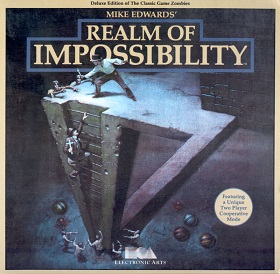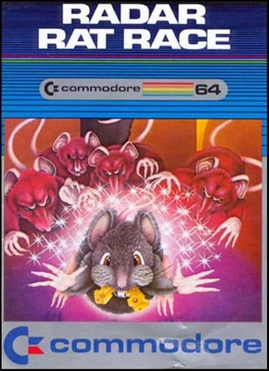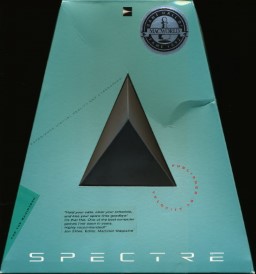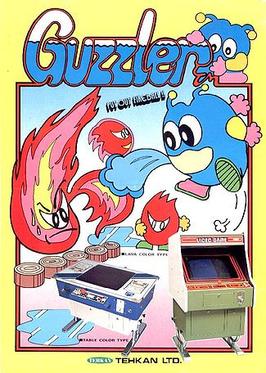
MIDI Maze, also known as Faceball 2000, is a networked first-person shooter maze game for the Atari ST developed by Xanth Software F/X and released in 1987 by Hybrid Arts. The game takes place in a maze of untextured walls. The world animates smoothly as the player turns, much like the earlier Wayout, instead of only permitting 90 degree changes of direction. Using the MIDI ports on the Atari ST, the game is said to have introduced deathmatch combat to gaming in 1987. It also predated the LAN party concept by several years. The game found a wider audience when it was converted to Faceball 2000 on the Game Boy.

Pac-Man, originally called Puck Man in Japan, is a 1980 maze action video game developed and released by Namco for arcades. In North America, the game was released by Midway Manufacturing as part of its licensing agreement with Namco America. The player controls Pac-Man, who must eat all the dots inside an enclosed maze while avoiding four colored ghosts. Eating large flashing dots called "Power Pellets" causes the ghosts to temporarily turn blue, allowing Pac-Man to eat them for bonus points.
A multiplayer video game is a video game in which more than one person can play in the same game environment at the same time, either locally on the same computing system, on different computing systems via a local area network, or via a wide area network, most commonly the Internet. Multiplayer games usually require players to share a single game system or use networking technology to play together over a greater distance; players may compete against one or more human contestants, work cooperatively with a human partner to achieve a common goal, or supervise other players' activity. Due to multiplayer games allowing players to interact with other individuals, they provide an element of social communication absent from single-player games.

Berzerk is a multidirectional shooter designed by Alan McNeil and released for arcades in 1980 by Stern Electronics of Chicago. Following Taito's Stratovox, it is one of the first arcade video games with speech synthesis. Berzerk places the player in a series of top-down, maze-like rooms containing armed robots. Home ports were published for the Atari 2600, Atari 5200, and Vectrex.

Ms. Pac-Man is a 1982 maze arcade video game developed by General Computer Corporation and published by Midway. It is a spin-off sequel to Pac-Man (1980) and the first entry in the series to not be made by Namco. Controlling the title character, Pac-Man's wife, the player is tasked with eating all of the pellets in an enclosed maze while avoiding four colored ghosts. Eating the larger "power pellets" lets the player eat the ghosts, who turn blue and flee.

Sabre Wulf is an action-adventure game released by British video game developer Ultimate Play the Game for the ZX Spectrum home computer in 1984. The player navigates the pith-helmeted Sabreman through a 2D jungle maze while collecting amulet pieces to bypass the guardian at its exit. The player does not receive explicit guidance on how to play and is left to decipher the game's objectives through trial and error. Sabreman moves between the maze's 256 connected screens by touching the border where one screen ends and another begins. Each screen is filled with colourful flora, enemies that spawn at random, and occasional collectibles.

Realm of Impossibility is an action game created by Mike Edwards for Atari 8-bit computers and published by Electronic Arts in 1984. It was originally released in 1983 as Zombies by BRAM, a company formed by Edwards and a friend. BRAM previously developed and published Attack at EP-CYG-4.

3D Monster Maze is a survival horror computer game developed from an idea by J.K. Greye and programmed by Malcolm Evans and released in 1981 for the Sinclair ZX81 platform with the 16 KB memory expansion. The game was initially released by J. K. Greye Software in December 1981 and re-released in 1982 by Evans' own startup, New Generation Software. Rendered using low-resolution character block "graphics", it was one of the first 3D games for a home computer, and one of the first games incorporating typical elements of the genre that would later be termed survival horror.

In computing, procedural generation is a method of creating data algorithmically as opposed to manually, typically through a combination of human-generated content and algorithms coupled with computer-generated randomness and processing power. In computer graphics, it is commonly used to create textures and 3D models. In video games, it is used to automatically create large amounts of content in a game. Depending on the implementation, advantages of procedural generation can include smaller file sizes, larger amounts of content, and randomness for less predictable gameplay. Procedural generation is a branch of media synthesis.

Radar Rat Race is a video game developed by HAL Laboratory released on cartridge in 1981 as a launch title for the VIC-20. The game is a clone of Namco's Rally-X arcade video game and was released in Japan as Rally-X (ラリーX) from Commodore Japan K.K. In 1982, ports were released for the MAX Machine and Commodore 64.

Advanced Dungeons & Dragons: Treasure of Tarmin is a video game for the Intellivision video game console and the Mattel Aquarius computer system. This game was a licensed Dungeons & Dragons adaptation. It is a successor game to Advanced Dungeons & Dragons: Cloudy Mountain (1982).

Spectre is a video game for the Macintosh, developed in 1990 by Peninsula Gameworks and published in 1991 by Velocity Development. It is a 3D vector graphics tank battle reminiscent of the arcade game Battlezone. One sequel, Spectre VR, appeared on a number of lists of best video games.

Snack Attack is a maze video game developed by Dan Illowsky for the Apple II and published by Datamost in 1981. Snack Attack is a Pac-Man clone.

In video games, first-person is any graphical perspective rendered from the viewpoint of the player character, or from the inside of a device or vehicle controlled by the player character. It is one of two perspectives used in the vast majority of video games, with the other being third-person, the graphical perspective from outside of any character ; some games such as interactive fiction do not belong to either format.

Serpentine is a maze video game written by David Snider for the Apple II and published by Broderbund in 1982. Serpentine's gameplay and visuals are similar to the Konami arcade game, Jungler, released the previous year. It was ported to the Commodore 64 and Atari 8-bit computers. A VIC-20 version was licensed to Creative Software.

Guzzler is a 1983 maze video game developed and published by Tehkan. It was licensed to Centuri for North American distribution. It was released as an arcade conversion kit, including a new marquee and control panel, then ported to the SG-1000 console. In Guzzler, the player controls a creature who can drink water from puddles, then extinguish fires and monsters spawned from those fires.

Wayout is a 3D first-person perspective video game programmed by Paul Allen Edelstein and published for the Atari 8-bit computers in 1982. It was released for the Apple II and Commodore 64 in 1983. Wayout is among the first maze games to offer full 360 degree 3D perspective and movement, and its graphics were considered state-of-the-art upon its release. There were many pseudo-3D maze games at the time, but they used a fixed perspective and limited the player to four orientations.

Quest of the Space Beagle is an action-adventure game written by Scott Lamb for Atari 8-bit computers and published by Avalon Hill Microcomputer Games in 1984. It's the sequel to Jupiter Mission 1999. A Commodore 64 port followed in 1985.

















